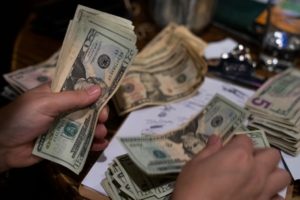Global incompetence saved the US dollar in 2022. It might seem counterintuitive, but the greenback had an impressive performance up until November 2022. The US Dollar Index (DXY), which gauges the greenback against a basket of currencies, had soared as much as 20% before falling back down to earth. Over the next 12 months, the chief international reserve currency faces a series of short- and long-term headwinds that might be challenging to overcome, even for the Federal Reserve.
The US Dollar Outlook in 2023
 The DXY is off to an abysmal start this year, falling about 1% to around 102.00. In the last three months, the index has plunged nearly 9%. According to Morgan Stanley, the pain may not be over, as the company anticipates the greenback finishing the year at 98.00, down from its previous estimate of 104.00. The Wall Street titan alluded to three key factors: slightly better-than-expected economic growth, global uncertainty fading, and higher yields abroad. The financial institution is primarily bullish on the euro, Canadian dollar, and the New Zealand dollar against the greenback this year.
The DXY is off to an abysmal start this year, falling about 1% to around 102.00. In the last three months, the index has plunged nearly 9%. According to Morgan Stanley, the pain may not be over, as the company anticipates the greenback finishing the year at 98.00, down from its previous estimate of 104.00. The Wall Street titan alluded to three key factors: slightly better-than-expected economic growth, global uncertainty fading, and higher yields abroad. The financial institution is primarily bullish on the euro, Canadian dollar, and the New Zealand dollar against the greenback this year.
One of the reasons why the US dollar had such an impressive performance in 2022 was the Federal Reserve leading the quantitative tightening charge compared to other major central banks. Unfortunately, the European Central Bank (ECB) was late to the game, and the Bank of England (BoE) had to temporarily hit the pause button to limit the damage in the UK bond market. The Eccles Building is now ostensibly closer to the end of the current cycle, meaning that interest rates will pause and potentially fall. However, the ECB has just started, and the BoE has more work to do, meaning other investment vehicles overseas are attractive for investors looking to park their money somewhere.
In addition, the US government will be bracing for a debt limit battle. Investors will be nervous as the Republican-controlled House may direct this year’s political theater and try to save the taxpayers a few billion dollars that will fall far short of how much interest Uncle Sam presently pays every year on the $31.5 trillion national debt. This will likely weigh on Treasury yields, but the battle’s impact on the greenback will depend on how equities are affected.
But while everyone on Wall Street is focusing on short-term movements, the long-term trends may be more important for the survival of the US dollar.
Russia, Saudis, and the World
Liberty Nation has gone into detail regarding the global de-dollarization push. The coronavirus pandemic manufactured plenty of chaos and uncertainty, which might have either accelerated or suspended the global monetary reset. Whatever the case may be, some data and developments suggest that the dollar is not as good as gold, as some on Capitol Hill have been led to believe.

(Photo by Jakub Porzycki/NurPhoto via Getty Images)
According to the International Monetary Fund’s (IMF) Currency Composition of Official Foreign Exchange Reserves (COFER), the US dollar’s share of international reserves tumbled more than 9% year-over-year in the third quarter of 2021, totaling about $6.441 trillion. The buck’s share of global forex reserves is the lowest it has been in 25 years. In addition, significant foreign holdings of US Treasury securities have been on a steady decline, recent data from the Treasury Department show. In October 2022, Chinese ownership of American debt plunged 15% year-over-year. Likewise, Japan’s share of US bonds slumped more than 18% from the same time in the previous year.
Are these two trends connected? It does suggest that there is less appetite for dollars and Treasurys.
So, what is happening exactly? The latest reports may act as a perfect summary of the greenback’s long-term future. Speaking in a Jan. 17 interview with Bloomberg TV, Saudi Minister of Finance Mohammed Al-Jadaan revealed that the Kingdom is open to discussing crude oil trade settlements in currencies other than the dollar. This comes nearly a year after The Wall Street Journal published a bombshell report that Saudi Arabia had been in active talks with China to price a portion of its crude sales to Beijing in yuan.
“There are no issues with discussing how we settle our trade arrangements, whether it is in the US dollar, whether it is the euro, whether it is the Saudi riyal,” he said. “I don’t think we are waving away or ruling out any discussion that will help improve the trade around the world.”
Today, it is estimated that three-quarters of oil transactions are priced in dollars. For the last 50 years, Riyadh has relied on the greenback for oil trading in exchange for security from the US government.
China and Russia are crucial players in this international push to wane addiction to the buck. President Xi Jinping wants to bolster a petroyuan to weaken the dollar as more resource-rich nations shift their efforts toward Asia. At the same time, Moscow aims to reduce its dependence on the US dollar by purchasing more Chinese yuan on the international currency market (Russia has been diversifying away from the buck since 2013). Moreover, there are now reports surfacing that Russia and Iran are partnering on a project to launch a gold-backed stablecoin to chip away at the volume of dollar-denominated payments in cross-border trade – Beijing and Moscow were on a gold-buying spree in 2022.
This is in addition to President Vladimir Putin’s other measures to ensure the dollar’s demise. Last year, for example, Russia and India established a rupee-ruble trade agreement to circumvent US-led sanctions. Moscow has tried supporting worldwide payment mechanism alternatives to the Society for Worldwide Interbank Financial Telecommunications (SWIFT) network.
Peak dollar talk may be premature, but the evidence is growing that hunger pains for the unbacked Federal Reserve Note are diminishing as many American adversaries feast on gold, the yuan, and more.
Gender Programs in Pakistan

(Tom Williams/CQ-Roll Call, Inc via Getty Images)
Many might be wondering why exactly the US dollar has yet to collapse. The United States maintains a $31.5 trillion national debt, runs an annual $1 trillion budget deficit, and forks over about $500 billion in interest payments. And yet there has not been a currency crisis. It may sound like Jerry Seinfeld, but what’s the deal with the dollar?
For one thing, it helps that 90% of the world’s transactions are completed in Abraham Lincolns, Andrew Jacksons, and Benjamin Franklins. If anyone dares dissent against US policy, the Washington leviathan and its many tentacles can cut off access. This is how the US dollar stays afloat after all these years, why more countries want to dismantle the dollar hegemony, and why taxpayers are forced to spend billions on gender programs in Pakistan and shoe-related initiatives in Ethiopia. This money is sent to these places – and who would reject free money? – and the allocation manufactures an artificial demand, propping up the greenback.
Until a viable substitute exists in the international community, the United States will need to continue weaponizing finance to ensure the dollar’s survival. Unfortunately, much like CIA coups and operations, there will be blowback – and the world may be watching it unfold in real-time.
Do you have an opinion about this article? We’d love to hear it! If you send your comments to [email protected], we might even publish your edited remarks in our new feature, LN Readers Speak Out. Remember to include the URL of the article along with your name, city, and state.
Please respect our republishing guidelines. Republication permission does not equal site endorsement. Click here.

